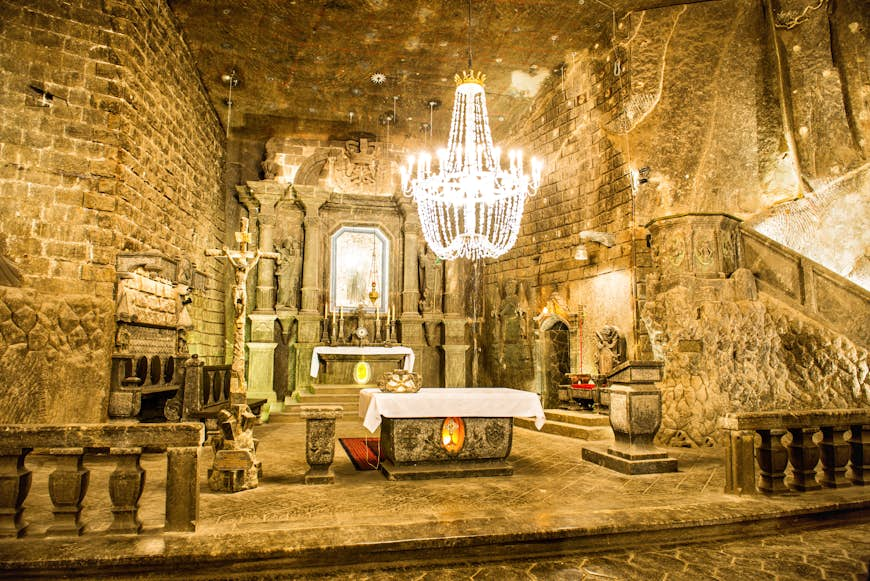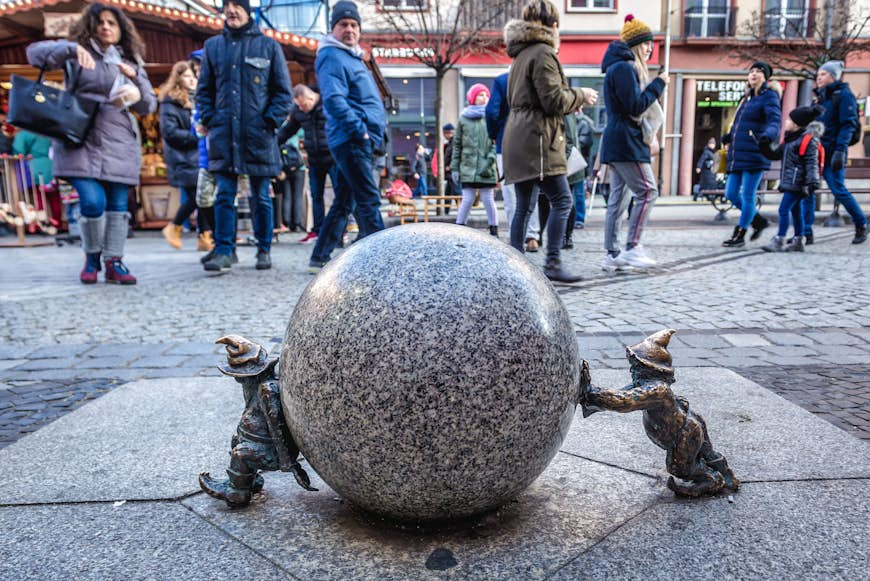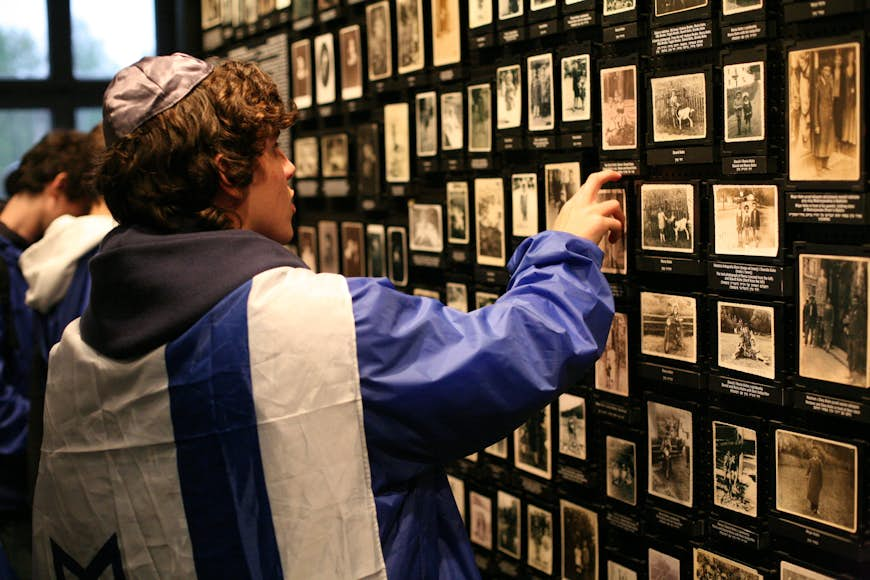With a glorious medieval town square, an immense food scene and many fascinating historical districts, Kraków is the cultural capital of Poland. But venture out of the city for a day and you’ll add even more context to your travels, while also experiencing other aspects of local life.
Whether it’s a trip to the harrowing grounds of Auschwitz, Nazi Germany’s largest concentration camp, or hiking though the Niepołomice forest, these five day trips give travelers a real peek into Polish culture.
Auschwitz-Birkenau Memorial & Museum
Why go: To understand the history of Kraków and the Nazi war crimes
Little has changed at Auschwitz-Birkenau – the largest extermination camp ever created by the Nazis – since it was liberated by the Soviets troops in 1945.
The black, wrought-iron sign that reads “Arbeit macht frei” (“Work sets you free”) still hangs above the entrance gates of Auschwitz I. It was the lie that would have greeted some 1.1 million Jews, Poles and Roma before they were murdered here, many in specially built gas chambers using the chemical agent Zyklon-B. Before the Nazi invasion, Poland was home to more than three million Jews, the largest population in Europe. By the end of the war, numbers had fallen to between 180,000 and 240,000.
Exhibitions detailing prisoners’ daily life are scattered around the site, giving a harrowing look into the heart of the concentration camp. While some prefer to self-tour, multi-language tours are the best way to see both sites, with added context and real stories provided by the guides. These leave every 15 to 60 minutes from the museum entrance. If exploring independently, allow at least 90 minutes to cover both camps. A free shuttle bus runs between the two.
How to get to Auschwitz from Kraków:
Located 66km (41 miles) west of Kraków in Oświęcim, you can reach Auschwitz by car in less than two hours. Buses are your best public transport option – they depart from the MDA bus station and go direct to the Auschwitz I museum doors. Eleven daily trains also run direct from Kraków; the trip takes about an hour and 50 minutes, and the train station is 2km (1.2 miles) from the museum.
Niepołomice Forest
Why go: To get active in the wilderness
From a 13th-century royal hunting ground to a wildlife haven for the continent’s largest mammal – the endangered wisent (European bison), about 30 of which roam freely here – the 110-sq-km (42-sq-mile) Niepołomice Forest is a vast natural wonder laced with marked and unmarked trails.
Pack a lunch – you’ve got a full day ahead. The 8km (5-mile) red path leads to the heart of the forest and to the edge of the wisent’s protected breeding grounds, while the 14km (8.7-mile) green trail follows the original Royal Road, which once cut through here, offering a more challenge hike. The 12km (7.5-mile) blue trail is a more sombre stroll, leading to mass graves of locals killed in WWII.
How to get to Niepołomice Forest from Kraków:
Bus 301 runs to Niepołomice town square, 26km (16 miles) east of Kraków, and from there it’s a 20-minute walk to the forest. Trains also go to the nearby towns of Stanisławice, Kłaj and Cikowice, each of which offers access to different areas of the forest.

Wieliczka Salt Mine
Why go: To marvel at the salt sculptures and murals
A labyrinth of tunnels and chambers, salt-built sculptures, cavernous sodium chloride chapels and striking NaCl chandeliers, the shafts of Wieliczka Salt Mine have been welcoming tourists since 1722. Only 14km (8.7 miles) from Krakow, the mine was producing table salt as recently as 2007 and is now one of Poland’s most popular attractions – you can see salt-mining technology in action and a spectacular underground lake.
Don’t plan to do anything else for the day as the Unesco world heritage site will keep you busy enough. Once you’ve quenched your salt-formation thirst, head above ground and enjoy a coffee in Wieliczka’s traditional town square.
How to get to Wieliczka from Kraków:
Wieliczka is reachable by train and bus in about 30 minutes. Several tour operators, including Cracow City Tours, offer bus tours to the mine, starting from 150zł, including admission.
Zakopane
Why go: For the mountains, and an authentic Polish holiday experience
At the base of the Tatra mountains sits Zakopane, the best-known mountain resort in Poland, offering spectacular views and crystal-clear lakes, no matter the season. With skiing in the winter and incredible hiking trails in the summer, this classic Polish holiday location is bursting with adventurous outdoor activities to occupy you for a day or a weekend – it’s easy to compare to the Alps.
Do you have time for a weekend here in the summer? Take the opportunity to venture out a little further to the Dunajec River Gorge and spend the day soaking up the sun, taking a leisurely float on a traditional wooden raft.
How to get to Zakopane from Kraków:
Buses leave from the MDA bus station once or twice an hour throughout the day; the journey takes about two hours. Zakopane is also accessible by a two-and-a-half-hour train ride, but there’s only one departure a day.

Wrocław
Why go: For the 300-plus dwarves hidden in the streets
As the fourth-largest city in Poland, Wrocław is bursting with culture and interesting attractions. Enjoy a hot wine in the vibrant Rynek (market square) before exploring the Prussian-, Bohemian- and Austrian-influenced architecture throughout this eclectic city. See the Gothic influence in the Old Town Hall facade, and climb to the top of the Cathedral of St John the Baptist for an incredible view over the city.
The birthplace of the Orange Alternative, the infamous anti-Soviet movement, Wrocław is historically significant too. A cheeky nod to the cultural crusade can be found in the form of 300-plus bronze dwarves, going about their everyday work on most street corners. Collect a map from the tourist information point to find them all.
How to get to Wrocław from Kraków:
Located 270km (168 miles) north of Kraków, Wrocław is a three-hour train ride away. Book your ticket in advance to guarantee a space on this popular train, either in person at the Kraków train station or online. If you have a car, driving is also an option – the A4 directly connects the two cities within a few hours.
